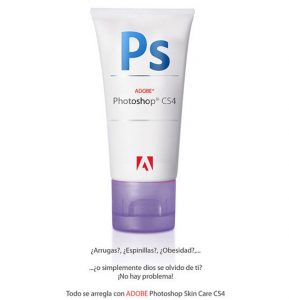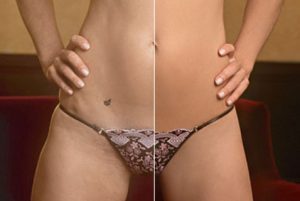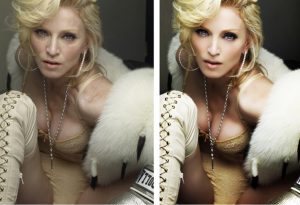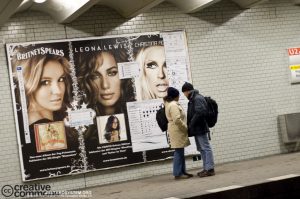How much time has gone by since you saw a natural model on a magazine cover? Tic TAC tic TAC tic TAC. Time is over, inevitably, and the famous Photoshop program has exceeded its use. Shrink your waist, increase the size of your bosoms, draw yourself a few beefy lips and … give yourself a touch up!

During the last year, there is probably not one photo or image that has not benefitted from a retouch before being published in the media. Photograph studios, magazines, newspapers, websites and advertising agencies use this program to “adorn” the details that the photo spontaneity do not have in spite of the lights and filters.
Meanwhile, models, actors and also politicians ask and demand that their campaigns or book images look better: Welcome to the digital artifice that acts magically on the natural imperfections and contributes to the construction that stereotypes themselves!
How does it work?
In a first step the photography in question is scanned or uploaded to a computer and then you can “work” on the image on the computer screen and (avoiding the idea of underestimating the amount of hours the art directors works) you can begin the transformation: “Rub out those wrinkles, reduce the waist and the left buttock, rule out the hip and put a smooth and stiff skin” An intense work in order that the product gets finished, and the contemporary virtual act of putting and removing turn body parts in a fantastic beauty stereotype.


Mirror, mirror on the wall… who’s the fairest of them all?
The pass of time on the body (and mostly the female one) is considered as a way of illness and deterioration. Unfortunately, this is the way of the market; big appearances to put nature against naturalness.
Evoking that hostile stepmother from the “Snow-White” tale, there is a woman who does not allow herself to get old and feel jealousy and envy for the beauty of the youngers. Today, in an obsessive wish to keep an everlasting youth, the unreal mirror called “photoshop” cooperates as a time machine.
Allies or Enemy
More than 80% of advertising images are touched. Normally, the concerned photographers and agencies are the ones who decide to manipulate it, but there are a lot of personalities that demand in advance that the Photoshop application is used. It’s clear that what models and celebrities most fear is to expose their bodies without tricks… and it is a one-way trip.
One example of that is Mariah Carey, who was gossip for the phothoshop excess and the beautiful Madonna. Beyonce, Penelope Cruz and… even Nicolas Sarkosy, president of France, made a bad impression when he cut his paunch in a photograph taken during his holidays.


The last straw
A few months ago, the design brand Ralph Lauren had to apologise for cuting (in an inacceptable extreme) the waist of a model. Before the fuss, the model Filippa Hamilton was to bid farewell to the campaign as she declared that the brand should give “a very big apology to all American women” because she considers that “a model should have a healthy look”.
On the other hand, Playboy Magazine Brazil published the photo of a model so “photoshopped” that they erased completely her navel. In the Argentine edition of the same magazine, they “arranged” for a photo a model left without a vagina.
Golden opportunity
As marketing strategy, several magazines have taken advantage of this boom in their favour: The most sold magazine in Germany, “Brigitte”, replaced the Photoshop with real women. “We are going to show women with identity. To the 18-year-old students, to the boss, to the musician, to the football players”, said proudly of the initiative the editor in chief of the magazine Andreas Lebert.
Let’s applause for this initiative and especially for the model Lizzie Miller who came out naked and showing that a model is a person with wrinkles … and beautiful folds in the paunch.
Another example is Mónica Belluci, Sophie Marceau and Eva Herzigova who resigned the photographic retouch through Elle Magazine from France. They suggested them to shoot and publish natural photographs… and see the results!

Another nice example is modelmanagement.com’s photo sessions. A company that photographs aspiring models in a natural and fresh way, showing new models without any retouching, so that agencies and anyone else for that matter can see the models as they really are… no tricks… no gimmicks.
Yin y Yan
In spite of the manipulation on model’s photos and the directl consequences on the ideal aesthetic of whom receives it, we cannot affirm whether Photoshop is a negative support in the digital age or not.
This software, and many others, also contributes with excellent technical options that allow professionals to optimize their work across the adjustment of brightness, focus, real colour and quality. Likewise, Photoshop has contributed many tools to the digital art in all it’s expressions.
The alarming thing appears when its use influences with a distort conception of reality, taking onto account the consequences as bulimia and anorexia.
The well known model Nieves Alvarez has given her opinion in the matter: “Now we are all relaxed very much with Photoshop, which is a very nice application inside of a few limits, but when they leave you, you look like a plastic doll”… its not ” The model of Madrid, who years ago has conquered the anorexia she also confesses: “…you have to have your life, your expressiveness … we are not porcelain dolls”

BY LAW 37.500 EUROS IF YOU DO NOT WARN THEM
The French deputy Valèrie Boyer (that belongs to the same politic party of Sarkozy) invokes that the “retouched” photos transmit womens stereotypes that can provoke psychological problems or nourishing disorders, and has presented a project of law where the fines come to 37.500 Euros if you do not warn that the image has passed by Photoshop.

This initiative is not only for the advertising campaigns, but it also includes the photo press, the artistic ones and even the politician signs which dress the hoardings during the electoral campaigns.

Thereby, the retouch images should be accompanied with this notice: “Photography retouched to modify the physical appearance of a person”. France follows United Kingdom steps, one of the first countries in being alerted to the harmful effects that the manipulation of the faces can have in the public.
I wonder what will have happen with the cosmetic surgeons? Have these digital liposuctions and lifting supplemented them? Or are they promoting their consultations with pieces of magazines to exemplify the phrase: “I WANT this nose”? In our hands we have several options to open a debate and to construct a reality that is simply how we want to appear to be.
More info: “The photoshop effect” / Campaña Dove / Arte Digital (DAM Berlín)






Add comment